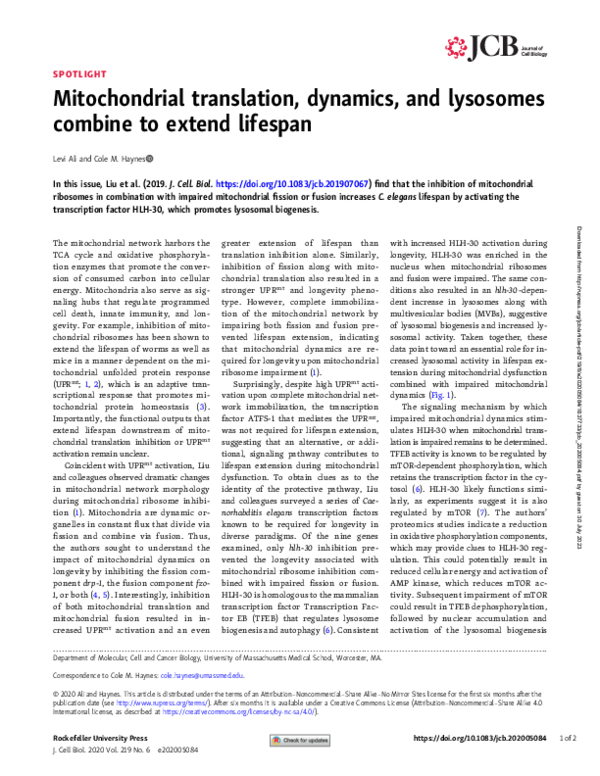Academia.edu no longer supports Internet Explorer.
To browse Academia.edu and the wider internet faster and more securely, please take a few seconds to upgrade your browser.
Mitochondrial translation, dynamics, and lysosomes combine to extend lifespan
Mitochondrial translation, dynamics, and lysosomes combine to extend lifespan
2020, Journal of Cell Biology
In this issue, Liu et al. (2019. J. Cell. Biol.https://doi.org/10.1083/jcb.201907067) find that the inhibition of mitochondrial ribosomes in combination with impaired mitochondrial fission or fusion increases C. elegans lifespan by activating the transcription factor HLH-30, which promotes lysosomal biogenesis.
Related Papers
Mitochondrial form and function, such as translation, are closely interlinked in homeostasis and aging. Inhibiting mitochondrial translation is known to increase lifespan in C. elegans, which is accompanied by a fragmented mitochondrial network. However, the causality between mitochondrial translation and morphology in longevity remains uncharacterized. Here, we show in C. elegans that disrupting mitochondrial network homeostasis by either blocking fission or fusion synergizes with the reduced mitochondrial translation to substantially prolong lifespan and stimulate stress response such as the mitochondrial unfolded protein response, UPRMT. Conversely, immobilizing the mitochondrial network through a simultaneous abrogation of fission and fusion reverses the lifespan increase induced by mitochondrial translation inhibition. Furthermore, we find that the synergistic effect of inhibiting both mitochondrial translation and dynamics on lifespan, despite stimulating UPRMT, does not requi...
Cellular and Molecular Life Sciences
Disruption of mitochondrial dynamics affects behaviour and lifespan in Caenorhabditis elegansNature Genetics
A systematic RNAi screen identifies a critical role for mitochondria in C. elegans longevity2003 •
Aging
Mitochondrial bioenergetic changes during development as an indicator of C. elegans health-span2015 •
Lysosomes signal the nucleus to control aging Folick et al. propose a mechanism by which a lysosomal enzyme influences nuclear events that control longevity in the worm (see the Perspective by Shuo and Brunet). Increased expression of the lysosomal acid lipase LIPL-4 increased longevity, and this effect depended on the presence of the lysosomal lipid-binding protein LBP-8. LBP-8 acts as a chaperone that helps carry lipds to the nucleus. The authors identified the fatty acid oleoylethanolamide (OEA) as a potential signaling molecule whose transport to the nucleus could activate nuclear hormone receptors and transcription factors NHR-49 and NHR-80. The transcriptional targets of NHR-49 and NHR-80 in turn regulate longevity. Science , this issue p. 83
2007 •
PLOS Genetics
A Regulated Response to Impaired Respiration Slows Behavioral Rates and Increases Lifespan in Caenorhabditis elegans2009 •
2016 •
Cells can enter quiescent states in which cell cycling and growth are suspended. We find that during a long developmental arrest (quiescence) induced by starvation, newly hatched C. elegans acquire features associated with impaired proteostasis and aging: mitochondrial fission, ROS production, protein aggregation, decreased proteotoxic-stress resistance, and at the organismal level, decline of mobility and high mortality. All signs of aging but one, the presence of protein aggregates, were reversed upon return to development induced by feeding. The endoplasmic reticulum receptor IRE-1 is completely required for recovery, and the downstream transcription factor XBP-1, as well as a protein kinase, KGB-1, are partially required. Interestingly, kgb-1(-) mutants that do recover fail to reverse aging-like mitochondrial phenotypes and have a short adult lifespan. Our study describes the first pathway that reverses phenotypes of aging at the exit of prolonged quiescence.
Newlightism
Newlightism by Eld. Don Winkelman2009 •
A Series of Articles Published in the Landmark Missionary Baptist Views Concluded August, 2009. This paper highlights the misunderstandings surrounding the topic of charges against churches in the name of undefined, core elements within a fallible ecclesiastical construct known by the formed category, Newlightism.
RELATED PAPERS
2019 •
29th ACM Symposium on Virtual Reality Software and Technology
Combining embodiment and 360 video for teaching protection of civilians to military officersDigestive and liver disease : official journal of the Italian Society of Gastroenterology and the Italian Association for the Study of the Liver
Practice guidelines on the use of esophageal manometry - A GISMAD-SIGE-AIGO medical position statement2016 •
International journal of engineering research and technology
Smart Garbage Separation Robot with Image Processing Technique2018 •
Journal of Petroleum Science and Engineering
Forecasting OPEC crude oil production using a variant Multicyclic Hubbert Model2015 •
Zenodo (CERN European Organization for Nuclear Research)
Handbook of Multi-Hazard, Multi-Risk Definitions and Concepts2022 •
Stem Cells International
Optimization Manufacture of Virus- and Tumor-Specific T Cells2011 •
Call Girls In Katwaria Sarai Delhi
Get Sexiest girls●─── 9953189442 ≽ Call Girls In Katwaria Sarai | DELHI NCR2024 •
RELATED TOPICS
- Find new research papers in:
- Physics
- Chemistry
- Biology
- Health Sciences
- Ecology
- Earth Sciences
- Cognitive Science
- Mathematics
- Computer Science

 Levi Ali
Levi Ali